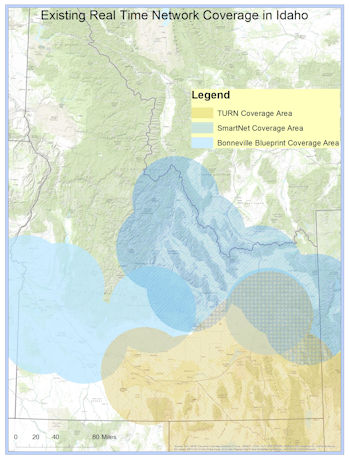A Real-Time Network for Idaho
Why...
To make the right decisions, location matters. That's why both geographic control points and global navigation satellite systems (GNSS) are critical pieces of Idaho's spatial data infratructure. A GPS operating all by itself though falls short of the needs and demands of today's world as its accuracy is gross enough to place you on the wrong side of a road. To alleviate this problem we can use a technology known as real-time correction. The way it works is pretty ingenious...simply connect a GPS to the Internet and receive a correction signal from local high accuracy base stations. The result is a location that will not only put you on the correct side of the road, but will place you correctly on a sidewalk!Where we are today...
Currently, there are three real-time correction networks functioning in Idaho. One is an extension of the Utah Reference Network (TURN) in southeast Idaho, the second is the Leica SmartNet functioning across eastern Idaho, and the third is a commercial network operated in the urban areas along the Snake River Plain. See inset map. Each of the three networks has area that overlaps one or both of the others, overlaps that could strengthen service if a network of networks (constellation) was created by linking the three together through software. Advantages of coordinating networks into a larger constellation are:
- Integrity monitoring - each base station is monitored by all others in the constellation.
- Fail-over fault tolerance - any troubled base station can be removed from the network without disrupting service, if the constellation has other stations positioned to cover the gap.
- Height Modernization - the National Geodetic Survey's Height Modernization program will benefit from a constellation of real-time networks extending over a greater, multi-state area.
- User Perspective - coverage from Las Vegas to Montana, or even Canada, if current discussions with collaborators in Montana are fruitful.
